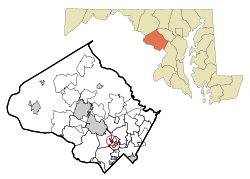Garrett Park, MD
| Garrett Park, Maryland | |
|---|---|
| Town | |

Aerial view of Garrett Park, Maryland, in January 2007.
|
|
 |
|
| Coordinates: 39°2′7″N 77°5′33″W / 39.03528°N 77.09250°W | |
| Country | |
| State |
|
| County |
|
| Incorporated | 1898 |
| Area | |
| • Total | 0.26 sq mi (0.67 km2) |
| • Land | 0.26 sq mi (0.67 km2) |
| • Water | 0 sq mi (0 km2) |
| Elevation | 285 ft (87 m) |
| Population (2010) | |
| • Total | 992 |
| • Estimate (2016) | 1,046 |
| • Density | 3,800/sq mi (1,500/km2) |
| Time zone | Eastern (EST) (UTC-5) |
| • Summer (DST) | EDT (UTC-4) |
| ZIP code | 20896 |
| Area code(s) | 301 |
| FIPS code | 24-31525 |
| GNIS feature ID | 0584560 |
| Website | www |
Garrett Park is a town in Montgomery County, Maryland. It was named for a former president of the Baltimore and Ohio Railroad, Robert W. Garrett. The population was 992 at the 2010 census. Garrett Park is home to Garrett Park Elementary School, just outside the town proper.
Garrett Park was incorporated as a town in 1898, with sponsorship by the Baltimore and Ohio Railroad, which in 1893 built a train station there. The town lies along the former B&O railway corridor (now used by CSX, Amtrak, MARC) and was named for Robert W. Garrett, a former President of the B&O. It was a planned community from the beginning - when the land it was built on was purchased by a businessman named Henry W. Copp in 1886, he intended to build a suburban development reminiscent of an English village. Copp even went so far as to name the streets after locations in the novels of the English author Walter Scott, such as Kenilworth and Strathmore. He also limited commercial development, and even today there is only one store in the town. Builders were given reduced rates to transport workers and materials to the town site, and new residents were given free trips to move in. Rail suburbs did not catch on in the area, however, and the community stagnated somewhat as automobiles replaced trains and streetcars as the primary means of commuting. In the 1920s, another company built approximately 50 more houses, these with garages. Much of the town is included in the Garrett Park Historic District, listed on the National Register of Historic Places in 1975. Garrett Park Elementary School, designed in 1928 by prominent local architect Howard Wright Cutler, has been designated as an historic site by the Maryland Historical Trust.
In May 1982 the townspeople of Garrett Park voted 245 to 46 to ban the production, transportation, storage, processing, disposal, or use of nuclear weapons within the town. This made Garrett Park the first nuclear-weapons free zone in the United States.
...
Wikipedia
